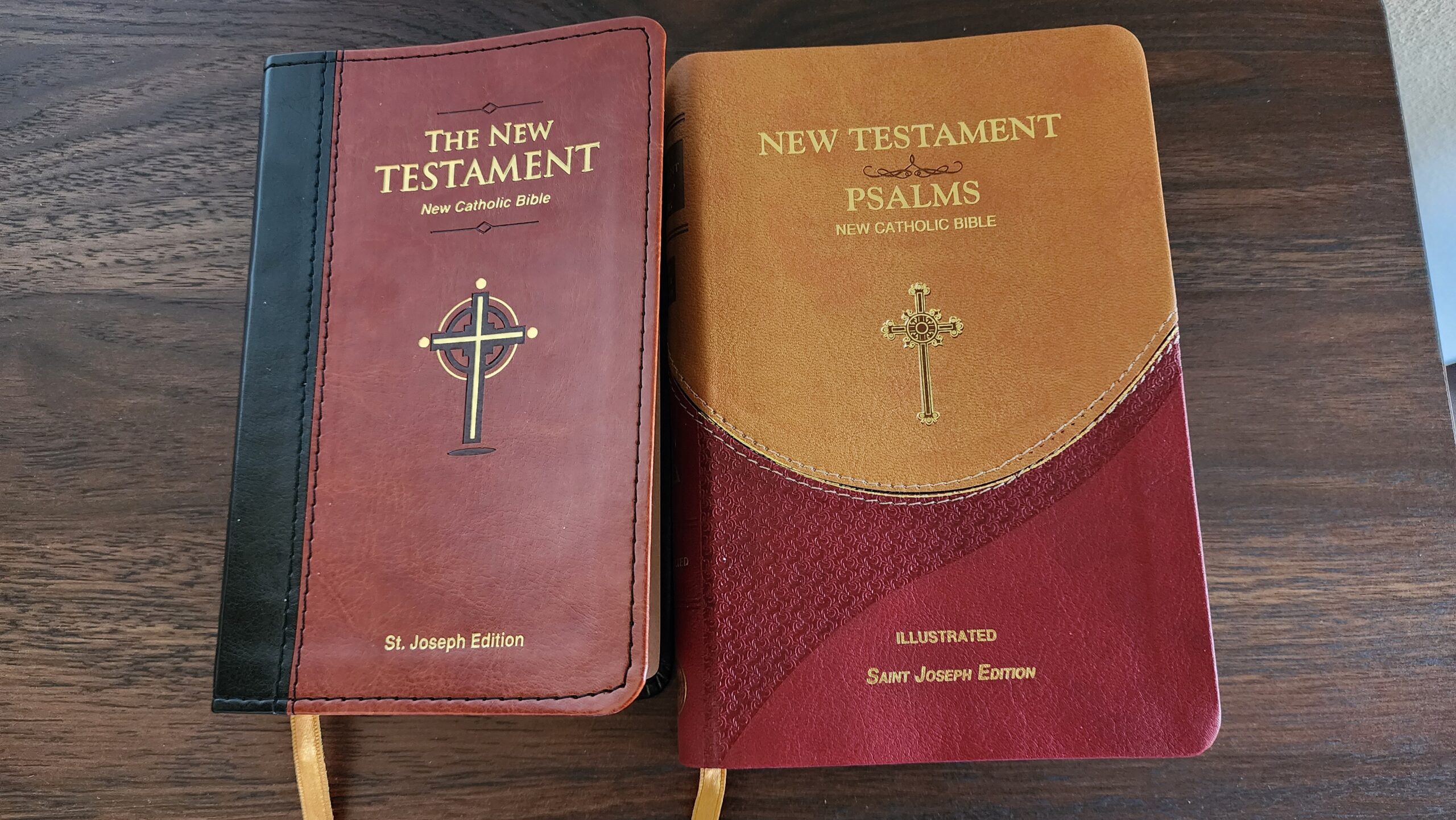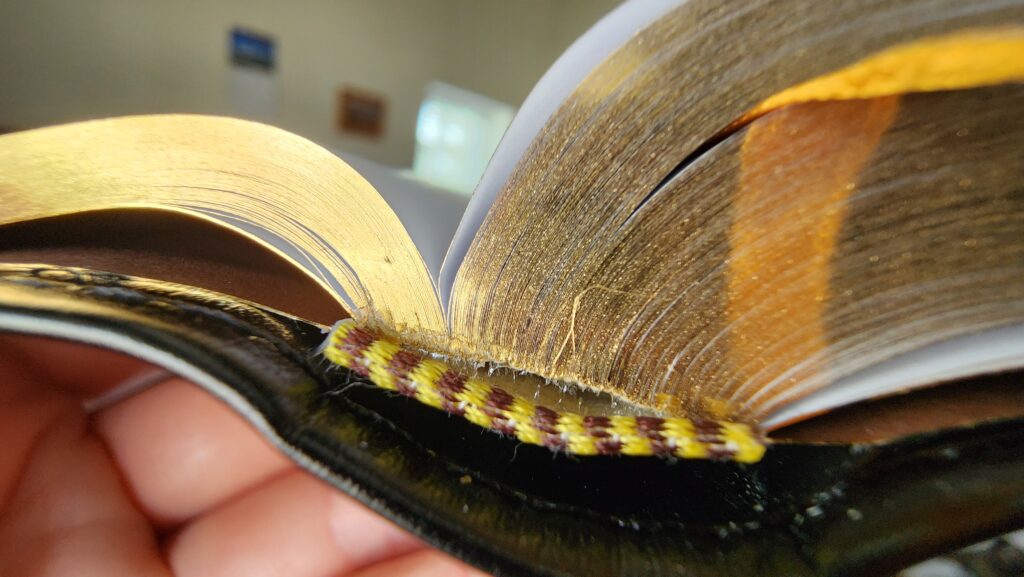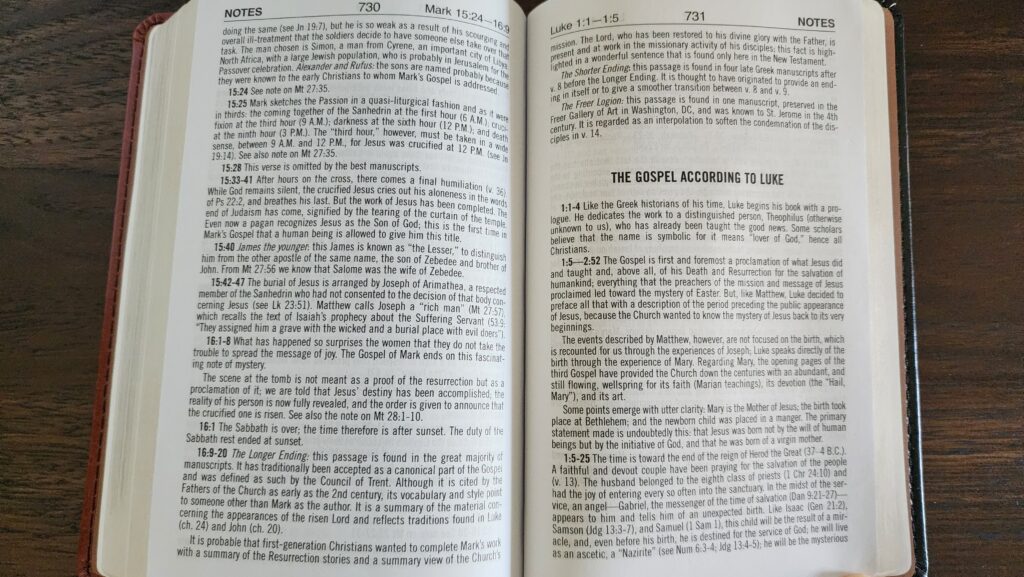
I recently purchased a couple of New Catholic Bible New Testament editions from Catholic Book Publishing Corporation (CBPC). These have been on the market for several years now (prior to the publication of the full Bible in 2019). There are multiple New Testament options to choose from in the CBPC product lineup. I chose their burgundy dura-lux New Testament and the two-tone brown and burgundy New Testament and Psalms.
CBPC offers many different cover styles and text layouts. All of their New Testaments are illustrated (with either black-and-white or color illustrations interspersed throughout the text). Furthermore, all of the editions that include both the New Testament and Psalms are formatted with footnotes on each page and red letters for the words of Jesus, while all the editions that feature only the New Testament are formatted with endnotes instead of footnotes (the notes for all books are grouped together in a single section at the back). The New-Testament-only editions are available in black letter and red letter options. The burgundy edition I purchased is a black-letter edition.
Both editions I purchased are portable, but I wouldn’t classify either one as truly “pocket-sized.” The burgundy New-Testament-only edition is smaller, but as the photo below shows, it is still notably thicker than my Cambridge REB New Testament. The New Testament and Psalms edition is very similar in size to the Pauline NABRE New Testament and Psalms which I reviewed last year.

Both editions have a sewn binding with a single basic ribbon marker and excellent gold gilding on the page edges. Out of all the books I’ve reviewed, CBPC’s books are the hardest for me to tell whether the binding is sewn or glued. It is very difficult to see the individual signatures near the spine, and in this case, I could barely see them with the naked eye. Extreme close-up photos with my camera helped to reveal them better than I could see on my own:
The paper and print quality in both of these editions is excellent. Ghosting is very minimal, and the text is clear and easy-to-read. For pure readability, they are easily the best New Testaments I own. The font size in the burgundy New-Testament-only edition is actually a bit larger than the New Testament and Psalms, and it is a joy to pick up and read. I also enjoy having the notes at the end of the book where they are not a constant distraction.
As I mentioned earlier, both editions have illustrations interspersed throughout the text. The New-Testament-only edition has black-and-white illustrations, and the New Testament and Psalms edition has black-and-red illustrations (not full polychromatic color). In both cases, the illustrations are printed on the same paper as the rest of the text, so they are completely unobtrusive when turning pages and flipping from one book to another—unlike the outrageous and abominable glossy cardstock pages that are interspersed throughout the dura-lux editions of the complete NCB.
The image above also showcases the red-letter text in the New Testament and Psalms. It is printed clearly and consistently throughout with a similar crimson color compared to the personal size complete NCB.
I can easily recommend both of these New Testaments. They are not as portable as the Cambridge REB New Testament or the Cambridge NRSV New Testament and Psalms which I recently reviewed, but they have much larger font and are very comfortable to read. The dura-lux covers have a nice feel to them, and the prices are excellent. The list prices are:
Burgundy New Testament: $13.95
Two-tone New Testament and Psalms: $17.95





I am in the market for a NT to keep at work. I never consider this translation, is it solid? I really like that REB NT but that’s probably going to be a hunt to track down.
I think overall the NCB is a decent translation. It’s more dynamic than the NABRE, but still fairly formal. It’s not as dynamic as the REB. I did an in-depth look at the translation here, in case you haven’t seen it:
https://catholicbibletalk.com/2020/05/in-depth-with-the-new-catholic-bible-part-2-translation/
Cambridge reprinted the REB New Testament recently with a green imitation leather cover. It’s readily available on the market right now. Here’s an Amazon link:
https://www.amazon.com/Testament-Green-Imitation-Leather-RE212N/dp/1108796923
The NCB is a more conservative translation than the NAB, it is an attempt to make a translation that uses more traditional Catholic phrases, for example, it says “Hail Full of Grace” rather than “Highly favored” or whatever the conventional translations say today. Since Vatican II, Catholics have made the unnecessary concession to Protestants that “Full of grace:” is just completely wrong, even though even Protestant and secular scholars will admit, in unguarded moments that it is an acceptable translation, for example, see the Amplified Bible on this verse. However, because Catholic translations always include Protestant scholars and they want the translation to be ecumenical the Catholic translators tend to concede too much, so the NCB is by only Catholic scholars so these “ecumenical’ concessions are not made.
These small concessions might be worth it IF these Catholic translations (NAB, Jerusalem Bible, New Jerusalem, Christian Community, Revised New Jerusalem Bible, etc) actually WERE used by Protestants, but they aren’t. And not only are they not read by Protestants, but most Protestants don’t seem even to know these translations exist. S
I agree entirely with your Luke 1:28 comments. The 1611 KJV even gave “graciously accepted” and “much graced” as valid alternate translations of their “favored one” translation, which is them giving two choices of all but saying “full of grace” while avoiding that specific wording for denominational reasons. I know ol’ A. T. Robertson is usually appealed to as a non-Catholic—a Southern Baptist at that—who said “full of grace,” interpreted right, was a valid translation of the Greek.
And yep, the only one of those Catholic translations that got any traction in Protestant circles was the original Jerusalem Bible, and even then, only really among Anglicans and Episcopalians, and even then, only as a supplemental translation. Aside from the NCB, the Augustine Institute’s planned CSV is the only current Catholic translation I know of that’s unapologetic about being an in-house, sectarian translation for and by Catholics, even if at its core it’s yet another RSV clone. I’m not suggesting a return to sectarianism is a good thing, but even with Protestant scholars participating, they should be pleased to have their readings in footnotes at most.
If Protestants cared one way or the other about Catholic translations it might be worth small compromises in the wording of certain verses, but they don’t care in the slightest.
A couple months ago, Sean McDowell, a popular evangelical podcaster, had a guest one who was talking about his vast knowledge of Bible translations, “I’ve read nearly every translation in print”, he then followed up with “except for the Catholic ones, I have no knowledge of those”, yeah, who cares about Bibles produced for the biggest Church in the world which positively dwarfs evangelicalism which seems minuscule by comparison. I was frankly shocked by the dismissive attitude from someone bragging about his vast knowledge of Bible translations.
It really goes to show that American evangelicals have an incredibly inflated sense of self-importance compared to their size while also being incredibly insular.
I’m not shocked. Go onto any catholic social media page and it’s overwhelmed by evangelicals trying to “save our souls”. (I’m being sarcastic) I grew up in it. Probably explains my aversion to the king James and it’s descendants.
Not so much self-importance but you are correct about the insular, narrow, and parochial views of many evangelicals. They know the evangelical world and they think it encompasses all of Christianity. To many, evangelicalism is simply the default, and not just Catholics but also mainline Protestants, Orthodoxy, and everything else are a bizarre aberration. They don’t know anything beyond their little world. That is one of the main reasons I lost interest in evangelicalism because when I flirted with it in college.
I have an oddball version of the NCB NT which I only found in an Amazon listing where the NT is a nice 9 1/2 X 6 1/2 format. It’s perfect in terms of font and only 1/2 thick. I don’t see it on their website and you have to hunt for it on Amazon.
Forgive the long link
https://www.amazon.com/St-Joseph-Catholic-Bible-Testament/dp/1947070665?pd_rd_w=TGAAr&content-id=amzn1.sym.928be83d-9abb-4025-bc6e-e0aed5aed3c9&pf_rd_p=928be83d-9abb-4025-bc6e-e0aed5aed3c9&pf_rd_r=BGA0SCBJW7EEBT0RNRRK&pd_rd_wg=blu3A&pd_rd_r=3033b005-e6b1-42d5-a312-853e9f3835a1&pd_rd_i=1947070665&psc=1&ref_=pd_basp_d_rpt_ba_s_1_t
Thank you!
I love the edition referenced in this article but the one to which you liked looks awesome. I just grabbed one to try.
Be well.
My favorite pocket Bible is the CBPC Confraternity Illustrated Edition in Genuine Leather that came out in the 50s:
https://new.reddit.com/r/catholicbibles/comments/1adf9c5/whats_your_favorite_pocket_catholic_bible
I also like the Scepter Confraternity New Testament and the Ignatius New Testament & Psalms. The Scepter edition is the most pocketable of the three that I have.
Yes I do remember reading your review. The REB will always have special place in my heart as it the first Bible that I actually enjoyed reading. I grew up a kjv baptist. It was while reading the REB that began to realize the early was Catholic. I’m tempted to buy the paperback REB w apocrypha and have it rebound. The Bible should be something you want to read and not feel like a chore. Btw, I have picked up the CSV gospel of Mark. Curious to see how it holds up.